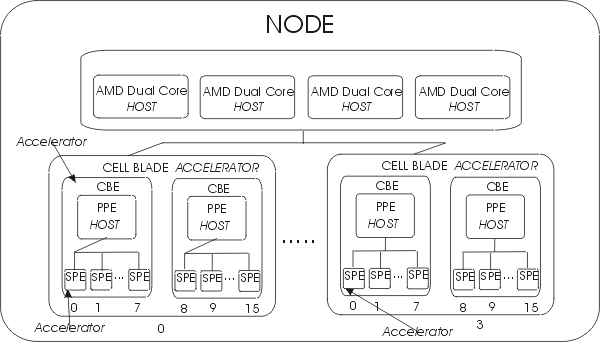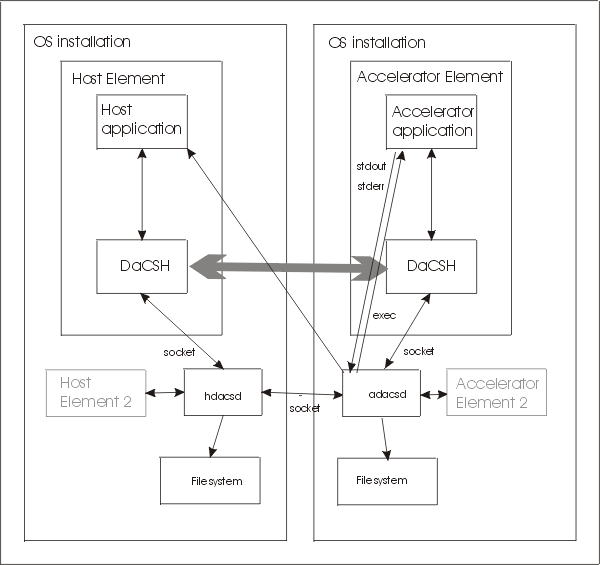DaCS for Hybrid (DaCSH) is an implementation of the DaCS API specification
which supports the connection of an HE on an x86_64 system to one or more
AEs on Cell Broadband Engines (CBEs). In SDK 3.0, DaCSH only supports the
use of sockets to connect the HE with the AEs. Direct access to the Synergistic
Processor Elements (SPEs) on the CBE is not provided. Instead DaCSH provides
access to the PowerPC® Processor
Element (PPE), allowing a PPE program to be started and stopped and allowing
data transfer between the x86_64 system and the PPE. The SPEs can only be
used by the program running on the PPE.
A PPE program
that works with the SPEs can also be a DaCS program. In this case the
program will use DaCS for Cell (DaCSC - see DaCS
Programmer's Guide and API Reference for Cell BE); the PPE will act
as an AE for DaCSH (communicating with the x86_64 system) and as an HE for
DaCSC (communicating with the SPEs). The DaCS API on the PPE is supported
by a combined library which, when the PPE is being used with both DaCSH and
DaCSC, will automatically use the parameters passed to the API to determine
if the PPE is an AE talking to its HE (DaCSH) or an HE talking to its AEs
(DaCSC).
In order to manage the interactions between the HE and the AEs DaCSH starts
a service on each of them. On the host system the service is the Host DaCS
daemon (hdacsd) and on the accelerator the service is the
Accelerator DaCS daemon (adacsd). These services are shared
between all DaCSH processes for an operating system image. For example, if
the x86_64 system has multiple cores that each run a host application using
DaCSH, only a single instance of the hdacsd service is needed
to manage the interactions of each of the host applications with their AEs
via DaCSH. Similarly, on the accelerator, if the CBE is on a Cell Blade (which
has two CBEs), a single instance of the adacsd service is
needed to managed both of the CBEs acting as AEs, even if they are used by
different HEs.
When a host application starts using DaCSH this connects to the hdacsd service.
This service manages the system topology from a DaCS perspective (managing
reservations) and starts the accelerator application on the AE. Only process
management requests will use the hdacsd and adacsd services.
All other interactions between the host and accelerator application will flow
via a direct socket connection.
The following diagram provides a summary of the DaCS daemons and their
relationships:
where:
- the host application (which uses DaCS) is assumed to be started outside
of the scope of DaCS;
- the broad arrow represents the flow of data (since only process management
requests are handled by the hdacsd and adacsd services);
- the lines marked 'socket' are control socket connections (DaCSd will be
a service that is called via ports reserved for DaCS usage. The connections
that will be created are between the hdacsd and the adacsd, and between the
adacsd and the host application, for stderr and stdout redirection.);
- more than one element (host and accelerator) is shown, as from the perspective
of the DaCS services it is shared at an OS installation level (multiple host
applications could be using the hdacsd, and multiple accelerator applications
could be using the adacsd);
- The stderr and stdout streams of an
AE application on the accelerator system are redirected to the HE application.
- For DaCSH the configuration information used for topology management will
be retrieved from the file system on the Host Element.
- The hdacsd and adacsd can be configured using configurations files from
the file system.
- The DaCSH daemons are user space programs, and are not privileged kernel
modules.
User Ids
The accelerator application will be started using the user id of the host
application. These user ids must already be setup on the accelerator.

